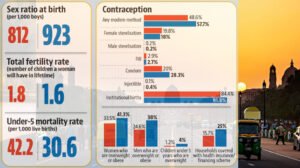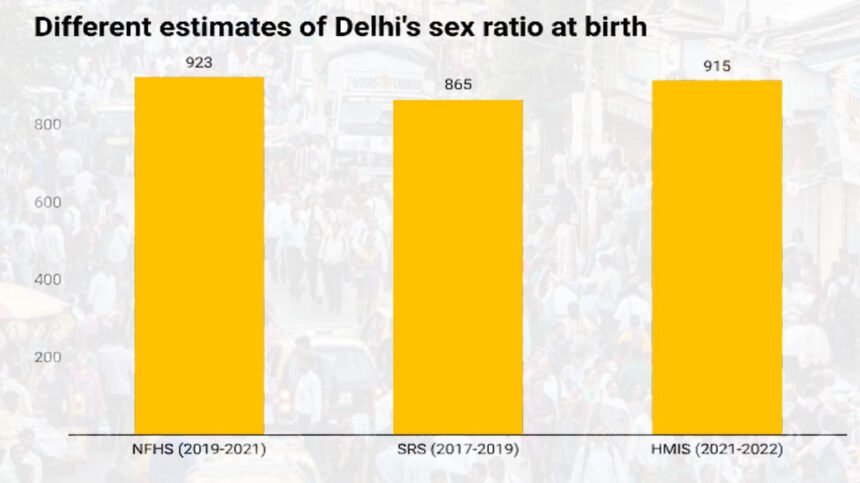Sex Ratio New Delhi :
The sex ratio at birth in Delhi is expected to decline from 932 a year ago to 929 in 2022, according to a report published by the Delhi government. The report also said the birth rate in Delhi increased from 13.1 per thousand population in 2021 to 14.2 in 2022, while the death rate declined from 8.3 per thousand population in 2021 to 6.1 last year, when the Covid pandemic was at its peak.
In 2018, 924 girls were born per 1,000 boys and 920 girls were born in 2019, which increased to 933 in 2020 and 932 in 2021. The report also revealed that the average number of births per day in Delhi has increased from 745 to 823. In 2021. 2022.
Average number of births per day increased from 745 to 823
Responding to data from the annual report on registration of births and deaths in Delhi for 2022, Arun Yadav, former director of hospital administration at the then North Delhi Municipal Corporation, said, “Sex ratio figures at birth showed a slight decline this year Has been.” ” ”, but this is a comparison of one year. If we look at the data of the last five years, a better trend is visible.
A Delhi government official similarly commented, “This is a very small decline in the sex ratio. We cannot completely dismiss those who choose not to have a second child if the first child is a son, but such thinking is prevalent in Delhi.” is prevalent in.” “It is rare, especially in urban areas.”,
The report revealed that the average number of births per day in Delhi increased from 745 in 2021 to 823 in 2022. Of the total births registered, 1,55,670 (51.8%) were male and 1,44,581 (48.1%) were female. of women, while 99 births were considered ‘other’ category.

Explaining the increase in birth rate, Yadav said, “It reflects multiple factors, such as improvement in health infrastructure, availability of better vaccines and medicines and migration. Many people are moving from other states due to better job prospects.” Have been.” “Migrate to Delhi.” The decline in mortality is evident, Yadav said, noting that 2021 was a pandemic year and it has severely impacted the city’s health infrastructure. The report also found that the mother’s age at the time of delivery was analyzed and it was determined that in maximum cases (37.5%), maternal age was 25–29 years, followed by 20–24 years in 30.6% cases and In 29.7% of the cases the mother was older. 29 years. It was also observed that in 2.2% of births the mother was under 19 years of age.
The leading causes of institutional deaths of infants in 2022 shows that 14.9% deaths were due to “septicemia”, 11.5% due to pulmonary and cardiac diseases, 7.6% due to shock, 4.4% due to liver diseases and 4.3% death Caused by. Reason. There may be some reasons. Tuberculosis disease. Covid Corona virus is the cause of 1.6% deaths. As “obstetrician Manisha Ranjan” explains, “Septicemia is mostly a problem in rural areas of Delhi where antenatal care is neglected. In urban areas, the chances of death due to septicemia are less. Therapies like ultrasound” “Conveniences can also aggravate pulmonary disease; treat circulatory and other cardiovascular conditions appropriately in a timely manner.”
Of the total births, 2,82,389 (94%) took place in health care centers and only 17,961 (5.9%) were of domestic nature. A total of 1,86,905 (66.2%) institutional births took place in government hospitals. According to Delhi government reports, most of the births (89.2%) were urban, while the percentage of births in rural areas was 10.8%. “Institutional deliveries were badly hit during the Covid period, but the situation has normalized and hospital births are likely to increase,” a government official said.
In terms of the incidence of home births, the majority of births (60.6%) occurred with the assistance of relatives. In fact, untrained midwives assisted in 25.6% of home births. Only 13% of births had a doctor, nurse or trained midwife present.
Read also : World Diabetes Day 2023: 10 foods that are increasing your Diabetes Risk





